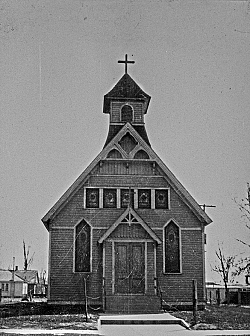The Centennial of Sacred Heart Parish: 100 Years of Faith, Gratitude and Community

By Armando Solórzano
Special to the Intermountain Catholic
The Most Rev. Joseph Glass, second Bishop of Salt Lake, declared Our Divine Savior Church a parish on Sept. 24, 1917, the same year that brought the end of World War I, a war that caused the deaths of 16 million civilians and military personnel. Pope Benedict XV, in unison with European and American bishops, raised a profound question to world leaders: “Where have we failed?” Catholics, and the rest of the world, felt the burden of not preventing death, pain and despair. In Salt Lake City, inspired by God’s grace, Catholics embraced our Savior and Redeemer Jesus Christ as the ultimate solution for suffering and violence. Thus, Our Divine Saviour Church, a microcosm of the divine mystery, was born. Some of the first people invited to attend and receive the sacraments at Our Divine Savior were Utah’s Catholic soldiers returning to Fort Douglas in Salt Lake City.
Our Savior Church was planned to unite the city’s east and the west sides; Seventh East and Third West were the church’s boundaries. Father Henry J. Wientjes, the first pastor, facilitated the donation of the parish’s first furniture, including the altar rail and the baptismal font, from the Cathedral of the Magdalene, which was under renovation at the time. The church grew with the arrival of Catholic miners. By 1929, the church was serving 110 families, some of which were struggling through the Great Depression. Msgr. Michael F. Sheehan, parish pastor from 1930 to 1950, installed running water, plumbing and gas. Our Divine Savior became a place of spiritual and material solace for the impoverished parishioners
World War II also left its mark on Our Divine Savior Parish. More than 60 million people lost their lives, and the universal message of Christianity – love, peace and compassion – became a preoccupation in the national consciousness and in that of the Salt Lake City Catholic community.
In 1950, responding to the need to create a stronger identity as Catholics in Utah and to advance the virtues of the Sacred Heart of Jesus, Father William E. Vaughn initiated the construction of a new church. Two years later, Fr. Vaughn oversaw the rededication of Our Divine Savior Church and its re-naming as Sacred Heart Church. Its most notable features were the 20 windows lining the east and west sides, which portray the history of Catholicism in the Americas and the history of the Catholic Church in Utah.
In 1992, the parish celebrated its 75th anniversary. Peggy Fletcher Stack, a reporter for the Salt Lake Tribune, highlighted the parish’s multi-ethnic composition: “Today [1992], Sacred Heart has a diverse ethnic composition. Approximately 60 percent are Hispanic – many are first-generation immigrants from Mexico, El Salvador, Colombia, Guatemala, Ecuador, Argentina, Chile, Honduras, Peru and Puerto Rico. The remaining population is composed of African-Americans, American Indians and members of Italian, Irish, Lebanese, Polish, Filipino, Japanese and Vietnamese descent.”
Over the years, the parish has been served by 38 priests, 26 nuns and sisters, and five deacons. Despite its small size – the building can accommodate only 400 people at a time – Sacred Heart Church possesses a charisma that invites people to dwell with the divinity of God’s love in an intimate and profound way. Through its 100 years, Sacred Heart Catholic Church has been known as “the home away from home,” “the little house,” “the immigrant church,” “the little church with the beautiful windows,” “the inner-city church” and “la casita.” All these names reflect Sacred Heart’s status as a spiritual sanctuary for people looking to be accepted and be part of the history of salvation.
Today, Sacred Heart Parish faces three significant challenges, all of which will persist into the future. The first is the need to increase the number of priests who can attend to the sacramental life of the church. Fr. Eleazar Silva Galvan, the 15th pastor of Sacred Heart Church, has said: “The duties of a priests don’t end inside the walls of the church; a priest has also to visit the sick of the parish, the prisoners, to bring the Eucharist to the home of those who can’t attend the Masses, to organize the different committees, especially of the young people who represent the future of the Church, and above all, to work with everybody to bring love, harmony and peace in the neighborhood.”
A second challenge is to unite the old generation of parishioners with the new immigrants who look for hospitality and inclusion.
The final challenge is to produce strong Catholic role models who can advance the message of justice and inclusion in the complex community of Salt Lake City.
The centennial of Sacred Heart is a testimony to the power of God’s grace, of the presence of the Holy Spirit that never cease to renew herself, and the fulfillment of the promise that God will always walk with His people.
Deacon Armando Solórzano was ordained in 2001. An associate professor of ethnic studies at the University of Utah, he is the author of three books.
© Copyright 2024 The Diocese of Salt Lake City. All rights reserved.

Stay Connected With Us